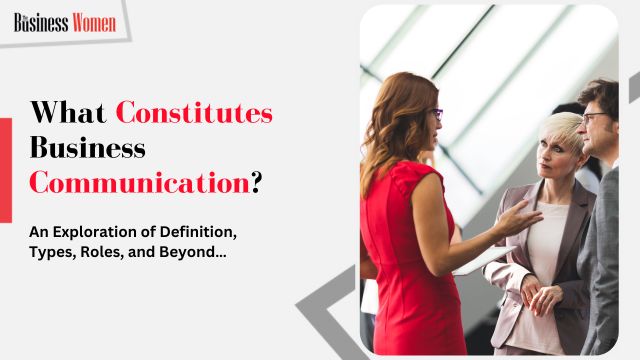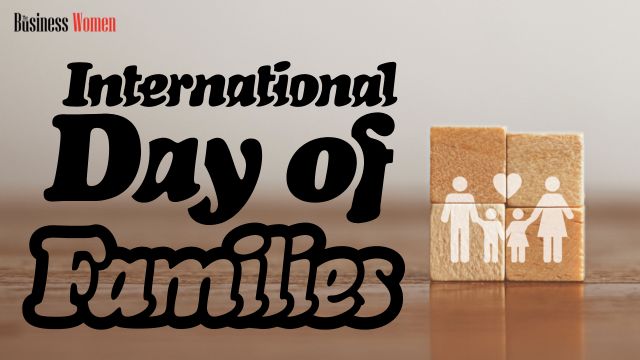An Exploration of Definition, Types, Roles, and Beyond…
Women entrepreneurs play a pivotal role in driving effective business communication. Within and beyond an organisation, the exchange of information becomes a catalyst for fostering interaction among female employees, management, and stakeholders, all working cohesively to achieve common goals, streamline organisational procedures, and minimise errors. Elevating communication practices, both internally and externally, emerges as a critical step for women entrepreneurs to enhance their business communication skills.
If you’re seeking to grasp the true essence of business communication from a women-centric perspective, this article is tailored to your needs. It not only underscores the profound significance of effective business communication but also offers guidance on enriching communication abilities and optimising processes within the workplace, ensuring that women entrepreneurs are at the forefront of effective communication practices.
Exploring Diverse Forms of Business Communication
Within the realm of organisational dynamics, an array of communication methods is harnessed to facilitate the exchange of information effectively. These modes encompass face-to-face meetings, telephone conversations, text messages, and traditional written formats. Understanding the nuances of different types of corporate communication is paramount, as they often necessitate adjustments in tone and content.
Internal Business Communication
Internal business communication revolves around the dissemination of information among members within an organisation, encompassing both formal and informal dialogues. It entails interactions spanning various departments and channels within the organisation. Proficient internal communication serves as a linchpin for comprehending and addressing organisational challenges. By nurturing effective internal business communication, an enterprise can boost employee job satisfaction, productivity, and operational efficiency while minimising grievances and augmenting revenues.
Lateral Business Communication
Lateral or horizontal communication refers to interactions between colleagues, be it verbal or written. This encompasses cross-departmental exchanges, communication across different segments within the organisation, and interactions among individuals holding similar positions within the company. Such communication is pivotal in achieving desired objectives. It occurs among individuals at the same hierarchical level and plays a pivotal role in fostering cooperation and mutual support to ensure the functional efficacy of distinct organisational units.
External Business Communication
External communication encompasses a gamut of communication forms, including email, advertisements, brochures, newsletters, and content marketing. It denotes the exchange of information with entities or individuals external to the company, such as clients, shareholders, suppliers, partners, regulatory bodies, and more. The ultimate aim of external communication is to facilitate effective interaction between different organisations or entities.
The Role of Business Communication
The roles of business communication are instrumental in determining a company’s success. Effective communication is often deemed the lifeblood of business operations. Here’s an elucidation of the significance of effective communication in various organisational contexts:
Top-to-Bottom Communication
Top-to-bottom communication involves the flow of information from senior management to lower-level employees within the organisation. When pivotal business decisions are made at the upper echelons, it becomes imperative to establish an efficient conduit for disseminating these decisions throughout the organisation. Adopting a top-to-bottom communication approach ensures that information is effectively transmitted from senior management to employees at all levels. When executed proficiently, this form of communication can break down silos, instil confidence in team members, and contribute to the organisation’s triumph. However, mismanagement can lead to productivity hindrances and the perpetuation of excessive hierarchical structures.
Peer-to-Peer Communication
Establishing strong relationships with colleagues is indispensable for day-to-day work interactions. While maintaining a positive rapport with one’s supervisor is essential, there may be days when direct communication with superiors is limited. Effective peer-to-peer communication allows us to collaborate successfully with coworkers by responding to queries, exchanging information, and providing feedback. Additionally, it nurtures a positive work environment, enhances team dynamics, and bolsters overall workplace contentment.
Bottom-up Communication
Bottom-up communication entails the dissemination of information throughout the organisation, stemming from lower-level managers and team members to higher-level management. While not as prevalent as top-down communication, bottom-up communication can be exceptionally effective. It empowers employees to contribute to high-level decision-making, offer feedback, and trust that their input will reach senior management. This form of communication fosters employee engagement, empowerment, and a sense of ownership within the organisation.
Importance of Business Communication
The importance of business communication is discernible across various facets:
Democratisation
Business communication assumes a pivotal role in ensuring equitable representation of minority voices in organisations with democratic decision-making processes. By fostering a culture of information sharing and data-driven communication from top to bottom, businesses can enhance their decision-making strategies.
Building Better Relationships
Communication allows management and employees alike to express their thoughts and requirements freely, fostering healthy labour relations and promoting a harmonious working environment.
Boosting Motivation and Morale
Effective business communication enhances employee efficiency by providing clear communication of plans, policies, organisational goals, and other crucial matters. This equips employees with the knowledge to perform their roles effectively, leading to heightened motivation and morale.
Job Satisfaction
Transparent, effective, and seamless communication enhances mutual understanding and connection between employees and management, contributing to higher levels of job satisfaction as employees feel valued and work towards achieving their goals.
Efficient Business Operations
Effective communication not only aids managers in carrying out various managerial activities like planning, directing, organising, and controlling but also supports qualitative leadership actions and ensures the smooth functioning of the organisation.
Enhanced Productivity
Effective business communication promotes teamwork, trust, and understanding between employers and employees. This enables employees to carry out their responsibilities more efficiently, reducing the likelihood of errors in their tasks and increasing overall productivity.
Facilitating Decision-Making
Effective communication provides managers with current information from various sources, enabling them to make sound decisions based on accurate knowledge.
Conflict Minimization
Excellent communication facilitates smoother information exchange among different business parties, reducing conflicts, debates, and disagreements. Effective business communication is essential for promoting transparency, collaboration, and success within an organisation.
Proper Planning
Effective business communication empowers organisations to develop robust plans and policies based on accurate information. These plans and policies need to be communicated within the organisation for successful implementation. Effective communication also allows organisations to convey strategies and policies to internal and external stakeholders.
The 7 Cs of Effective Communication
Irrespective of the field of operation, professional interaction with others holds paramount significance for business processes. By incorporating the principles of the 7 Cs, one can enhance productivity and engagement by delivering messages that the audience can readily comprehend.
Completeness
Effective communication necessitates providing all essential information to the audience. The sender should consider the recipient’s perspective and convey the message accurately. Complete communication offers several advantages:
- Establishing and improving an organisation’s reputation.
- Saving money by ensuring no crucial data is lost and avoiding additional expenses.
- Eliminating uncertainty by providing all necessary details.
- Enabling access to relevant information for better decision-making.
- Persuading the audience by delivering a comprehensive message that influences their understanding and decision-making.
Consideration
Consideration in communication entails empathising with the audience, taking into account their opinions, backgrounds, mindset, and educational level. It’s crucial to envision your audience and understand their needs, emotions, and challenges. Ensure that your message respects their self-esteem and emotions, adapting the language and content to meet their needs while maintaining completeness.
Conciseness
Conciseness in communication involves conveying the intended message using the fewest words possible while adhering to the other principles of effective communication. Concise communication offers various benefits:
- Time and cost savings.
- Focusing on the core message.
- Delivering a brief yet impactful message to the audience, ensuring clarity and ease of understanding.
- Captivating and maintaining the listener’s attention and interest.
- Avoiding unnecessary repetition.
Concreteness
Concreteness in communication involves being specific and explicit rather than vague and generic. It instils confidence in the audience. Simply delivering statements and questions is not enough to captivate your audience. It is crucial to support your claims with relevant facts, numbers, and statistics. This allows your audience to gauge the authenticity and credibility of your message.
Clarity
Effective communication is achieved when your thoughts and ideas are successfully transmitted to the recipient’s mind. Clarity ensures that the recipient does not make assumptions or have a vague understanding of your message. Only when they fully grasp your message can they make informed decisions. Using plain and straightforward language is key to conveying your point clearly to the recipient.
Correctness
Communication correctness entails both grammatical accuracy and factual reliability. It’s crucial to avoid grammatical errors in verbal and written communication. Additionally, ensuring the accuracy of the information being conveyed is paramount. Choosing the right words at the right time and verifying the reliability of the information enhances the correctness of communication.
Courtesy
Courtesy in communication means that the message reflects the sender’s expression while also respecting the receiver. The sender should demonstrate honesty, politeness, prudence, thoughtfulness, empathy, and enthusiasm in their message. Maintaining a respectful and considerate tone contributes to effective and positive communication.
Understanding Communication Barriers
Communication barriers encompass impediments that hinder effective communication, irrespective of the communication mode—whether spoken, nonverbal, written, listening, or visual. Beyond physical and technological hindrances, several common communication barriers necessitate proactive efforts for mitigation, encompassing both employee and management roles.
Differences in Cultural Background
Understanding and respecting cultural disparities in communication is pivotal. It’s essential to adopt a global mindset and be cognizant of cultural norms. Additionally, regional distinctions may exist within an organisation, and failing to appreciate these cultural nuances can inadvertently offend someone.
Not Listening to Others
Active listening is a crucial facet of effective communication. When individuals fail to genuinely listen to others, they rely on assumptions and preconceived notions, impeding understanding and connection.
Absence of Transparency and Trust
The dearth of transparency and trust renders open expression challenging. If employees perceive information as being withheld, it fosters anxiety and speculation, making it difficult for them to absorb communication efforts.
Workplace Conflicts
Conflicts can emanate from various sources, and when they occur, they hinder efficient communication. Focusing on resolving the conflict itself, rather than dwelling on its nature, is essential. Unresolved disagreements escalate, leading to factions and further impediments to effective communication.
Communication Style
Every individual possesses a unique communication style. Some are direct and to the point, while others prefer a more indirect approach. People may rely on specific facts or broad strokes when conveying information. Difficulties may arise when individuals are entrenched in their communication style and struggle to communicate effectively with those who have a different style.
By recognising and proactively addressing these communication barriers, individuals and organisations can cultivate an environment conducive to effective and meaningful communication.
Examples of Effective Business Communication
Nonverbal Communication
Proficient nonverbal communication through body language is indispensable. Maintaining eye contact, sitting attentively, and positioning your body to face the speaker demonstrate engagement and readiness to communicate. Conversely, crossing your arms, clenching your fists, or avoiding eye contact can convey disinterest or distraction, hindering the conversation.
Active Listening
Active listening enables a better understanding of the thoughts and feelings of others. To practice active listening, focus your attention on the person speaking, refrain from interruptions that can disrupt the conversation’s flow, and show genuine interest. Providing feedback further demonstrates your comprehension.
Open-mindedness
Being open-minded is crucial for facilitating effective communication. Avoid passing judgment or criticising the messages being conveyed. While you don’t have to agree with someone’s beliefs or opinions, respecting them and creating an environment that encourages open and respectful dialogue is important.
Compromise
Effective communication often entails finding solutions through compromise. When facing a problem or disagreement, both parties must collaboratively generate potential solutions and reach mutually agreed-upon compromises. This fosters cooperation and ensures that both parties’ needs are considered.
In Conclusion
Effective communication serves as the cornerstone of successful organisational dynamics, fostering employee relationships and engendering a sense of community. While some companies promote an open culture, encouraging transparent communication among employees at all levels, others adhere to a hierarchical structure. Regardless of the approach, effective business communication remains paramount in cultivating a conducive work environment conducive to outperforming competitors.
Summary
- Business communication involves efficient message exchange in corporate and organisational settings.
- Objectives include relationship building, learning facilitation, trust fostering, and positive public image maintenance.
- Communication occurs internally, laterally among coworkers, and externally.
- Communication flows upstream, downstream, and peer-to-peer within a business.
- Barriers can obstruct effective communication, affecting message clarity and understanding.
- Business communication is dynamic, evolving through assessment, observation, and implementation of changes.








